Are you worried with your poor Google AdSense revenue despite having a decent traffic to your website, and want to increase your AdSense earnings? You are in the right place.
I will give you 8 important tips to increase your AdSense revenue + explain all the important terms related to AdSense earnings.
Google AdSense is a great platform to earn hundreds of thousands of dollars per month. There are blogs, YouTube channels and websites from which people are actually earning thousands of dollars per month because they know the art of how to earn revenue from Google AdSense.
When you will go through the Tips you will get to know that what were the important things and practices you were missing.
An average blogger or YouTuber who struggles with AdSense earnings has RPM around $0.40 to $0.70 which means that he hardly earns $40 to $50 from 80,000 to 1,00000 views per month whereas bloggers and YouTubers who follow the proper practices have RPMs higher than $5-$10 and are earning good money.
Following topics will be covered in this post:
- What Are RPM, CTR & CPC
- How To Earn $100/Per Day With 15,000 Visits Per Day
- 8 Tips To Increase Your AdSense Revenue
01. What Are RPM, CTR & CPC?
It is important for you to fully understand the RPM, CTR, & CPC because you will come across these terms again and again on Google AdSense + these terms help you to understand how your AdSense earnings are calculated and how a change in their value impacts your earnings.
01. RPM (Page Revenue Per Thousand Impressions)
Page RPM is the average earnings per thousand page views. RPM is calculated by dividing your estimated earnings by the number of page views you received, then multiplying by 1000.
RPM is calculated by this formula:
- RPM = (Estimated earnings / Number of page views) x 1000.
For example, if you earned an estimated $0.20 from 25 page views, then your page RPM would be equal to:
- RPM = ($0.20 / 25) x 1000 = $8.
How To Check RPM On AdSense
Follow the steps to check the RPM on AdSense account.
- Go to your Google AdSense account.
- Click on the Reports from the sidebar.

- You can see the Page RPM, it is $0.77 for Last 7 Seven Days. By default Google AdSense shows you the RPM of last 7 days. You can change the number of days or can select a custom date.
- Click on the Page RPM to see its graph.
- You can also filter the Report results from Break down by. I have selected the Date. You can select other options as well such as Ad format, Ad network, Ad size, Bid type, Custom channel, etc.

02. CTR(Clickthrough Rate)
A CTR is a ratio or percentage showing how often people who see your ad end up clicking it. CTR can be used to measure how well your keywords and ads are performing. It is the number of clicks that your ad receives divided by the number of times your ad is shown.
A high CTR is a good indication that users find your ads helpful and relevant. You can use CTR to measure which ads and keywords are successful for you and which need to be improved. The more your keywords and ads relate to each other and to your website content, the more likely a user is to click on your ad.
CTR is calculated by this formula:
- CTR = (Clicks ÷ Impressions) x 100.
For example, if you had 10 clicks and 200 impressions, then your CTR would be 5%.
Here is how:
- CTR = (10 ÷ 200) x 100 = > (0.05) x 100 = 5%.
How To Check CTR on Google AdSense
Follow the steps to check the CTR on Google AdSense.
- Go to your Google AdSense account.
- Click on the Reports.
- Click on the CTR tab to see the graph.
- You can see that the CTR is 0.28% for Last 7 Days.
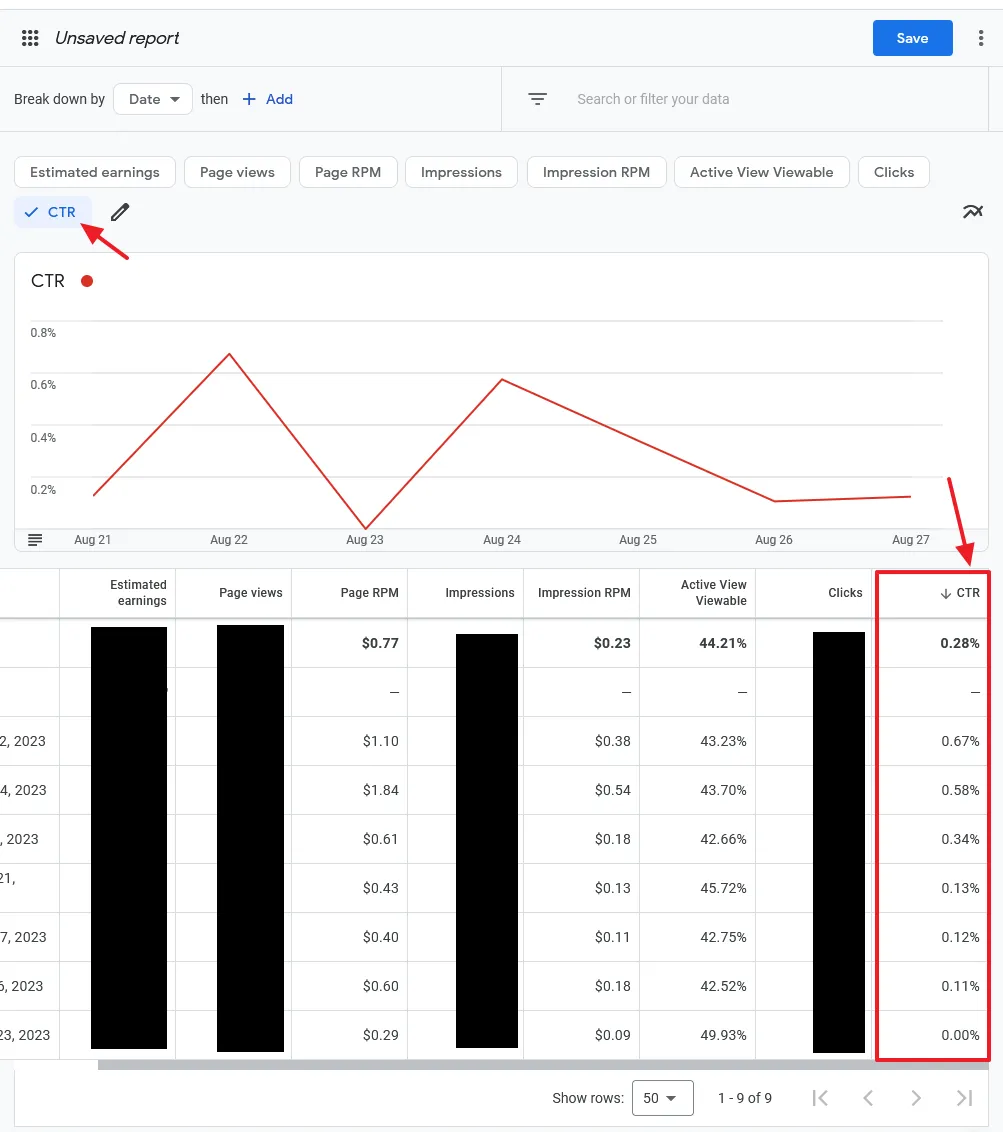
Each of your ad units and keywords have their own CTRs that you can see listed on your Google AdSense account.
- Select Ad unit from Break down by.
- Click on the CTR tab to see the graph.
- Scroll down to see the CTR of each ad unit.
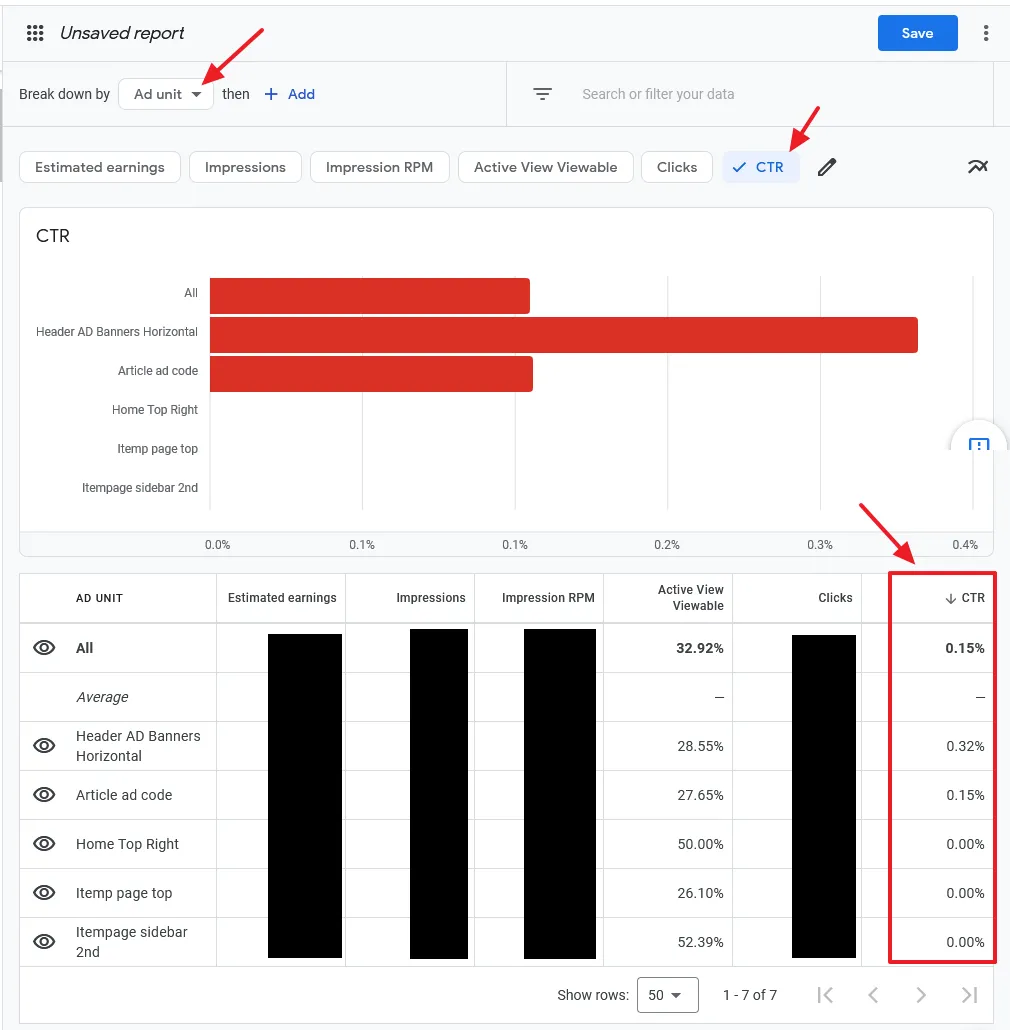
03. CPC(Cost Per Click)
The CPC is the amount you earn each time a user clicks on your ad. CPC is calculated by dividing the estimated earnings by the number of clicks received.
CPC is calculated by this Formula on AdSense report:
- CPC = Estimated Earnings / Clicks.
For example, your Estimated Earnings is $5.46 for 66 clicks then your CPC would be $0.08.
- CPC = 5.46 / 66 = $0.08.
How To Check CPC On Google AdSense
Follow the steps to check the CPC on Google AdSense account.
- Go to your Google AdSense account.
- Click on the Reports.
- Click on the CPC tab to show its graph.

Each of your ad units and keywords have their own CPCs that you can see listed on your Google AdSense account report.
- Select Ad unit from Break down by.
- Click on the CPC tab to view the graph.
- Scroll down to see the CPC of each ad unit.

02. How To Earn $100/Per Day
You must have good understanding of RPM, CTR, & CPC now. So let’s do an example that how you can earn $100/per day with a traffic of 15,000 visits per day.
Let’s assume that your CTR is 1%, CPC is $0.5, and your RPM is $2.
The formula is:
- Earnings Per Day = (Visitors x CTR% x CPC) + (Visitors/1000 x RPM).
Put the values into the formula:
- (15000 x 1% x 0.5) + (15000/1000 x 2) = > (15000/100 x 0.5) + (15 x 2) = 75 + 3 = $105
8 Tips To Increase AdSense Revenue
These are the 8 important tips to increase your AdSense Revenue up to 30% and even more.
01. Create More Quality Content
More quality content leads to more visitors and make your website rank higher on SERPs which ultimately brings more clicks to your ads.
Consistently create quality content for your website.
Do you know that exactly when you become a successful blogger?
Answer is when at least more than 70% of your articles bring traffic to your blog consistently. When people start blogging, for first 1 to 2 years only 10% to 15% articles are ranked on Google, but rest of the articles remain idle and Google ignores them.
You can research on those articles which are ranked on Google and bringing traffic to your blog like what are the things that you have done correctly there.
Quality content involves lot of things like the content should be original and around your article’s title, and your article must fulfill what ever your title suggests.
If you are providing a solution make sure to write the content by focusing the visitor not search engines like what could be the best content that will satisfy or impress the visitor and solve his problem.
Make sure to optimize the images and always write meaningful names and add image Title & Alt text.
Whenever you write articles make sure to consider the mobile view as well because Google bots & crawlers give preference to mobile-friendly content more. Bloggers mostly write articles from their computers so they always think of desktop view of articles.
First 2 paragraphs of your article are always very important, so in the 1st paragraph define the problem and in the 2nd paragraph briefly give an introduction or explain your solution. After publishing your article don’t forget to review because it might need necessary changes or updates.
From SEO point of view the ideal length of blog post is 25,00 words or 1000 to 2500 words. There should be enough content on your article that AdSense will find the right ads.
02. Create High CPC Content
Creating high CPC content is one of the important things that most of the bloggers miss and have no idea. Bloggers and YouTubers who know the art of creating high CPC content are the ones who actually earn big amount of money from Google AdSense.
CPC as you know is the cost per click as I have explained above plays a very important role in your AdSense earnings. Do you know that every keyword or keywords have a different CPC. Advertisers pay different amount for different keywords based on location and network.
There are two terms in Google AdSense i.e. Top of Page Bid(Low Range) & Top of Page Bid(High Range) that define how much advertisers pay for different keywords per click.
Top of page bid(low range) tells you the lower range of what advertisers have historically paid for a keyword’s top of page bid, based on your location and Search Network settings. The average CPC of your keywords may vary.
Top of page bid(high range) tells you the higher range of what advertisers have historically paid for a keyword’s top of page bid, based on your location and Search Network settings. The average CPC of your keywords may vary.
Average CPC varies widely by business and industry type, but the average CPC across all industries is approximately $2 to $2.32.
Here are some of the keywords that have the highest CPCs:
- Insurance: $59 CPC
- Gas/Electricity: $57 CPC
- Loans: $50 CPC
- Mortgage: $44 CPC
- Attorney: $48 CPC
- Lawyer: $43 CPC
- Donate: $42 CPC
- Conference Call: $42 CPC
- Degree: $40 CPC
- Credit: $38 CPC
If your blog niche or content is relevant to these keywords your AdSense earnings will be much higher than others. For Example, you have a blog about finance where you write about economy, banking, insurance, car insurance, etc.
Now Google AdSense after assessing your content will show ads relevant to finance and insurance. Relevant ads greatly increase the number of clicks on ads that ultimately leads to high earnings.
Remember that every keyword has different Bid Rate per click and it also varies from country to country. Advertisers from countries like United States, UK, Norway, Canada, etc, offer high bid rates as compared to countries like India and Pakistan.
Let’s take an example of two different keywords one with low CPC and one with high CPC. I searched the CPC of keyword “blogging”, its lower range is only $0.030 and higher range is $0.22. If someone will click on ads relevant to keyword “blogging” you will earn in between this range per click.
Then I searched for keyword “insurance” by setting the location United States. The lower range for keyword “insurance” is $16.09 per click and the higher range is $61.52 per click. I also searched for a keyword “car insurance”, its higher range is $153.89 per click.
The keywords that have higher CPC there is HIGH competition and where the CPC is low there is LOW competition on Google.
Here you can see that a random advertiser has paid $7.01 for a single click.

But How To Find the High CPC Keywords?
By Keyword Research Tools. There are plenty of keyword research tools in market like SEMrush, Adzooma etc, but they are not free. Google Ads offers one of the best free keyword research tool i.e. Google Ads Keyword Planner.
The above CPCs of keywords were collected from Google Keyword Planner.
I have created a separate article for Google AdSense Keyword Planner where I have guided on how to signup for Google Ads and how to use access and use Google Keyword Planner..

03. Focus On Top Earning Posts
By focusing on your top earning posts you can take lot of information from them like why they are working well and bringing consistent traffic and why some pages don’t. You can also make necessary updates to improve their performance further.
The more traffic a post/page brings to your website there is higher probability of number of clicks on ads.
Your blog Stats & Google Analytics provide you the detail information about the posts which bring the most number of visitors.
04. Enable All Ad Formats
Google AdSense offers 5 ad formats. By enabling them you can greatly increase your AdSense revenue.
- In-Page Ads
- Matched Content
- Anchor Ads
- Vignette
- Side rail ads
The In-Page Ads (Auto Ads) are those ads that appear within the content of your posts and pages. AdSense automatically inserts these ads by finding the suitable places.
The Matched Content is a promotion tool that can increase revenue and engagement by showing ads relevant to your content.
The Anchor Ads are those ads that stick to edge of the user’s screen and easily dismissible.
The Vignette Ads are mobile full-screen ads that appear between page loads.
The Side rail ads are those ads that stick to the sides of the screen as page is scrolled.
How To Enable/Disable AdSense Ad Formats
Follow the steps to enable/disable AdSense ad formats.
- Go to your Google AdSense account.
- Click on the Ads from sidebar.
- On the All your sites section in front of your website URL click on the Pencil (Edit) icon.
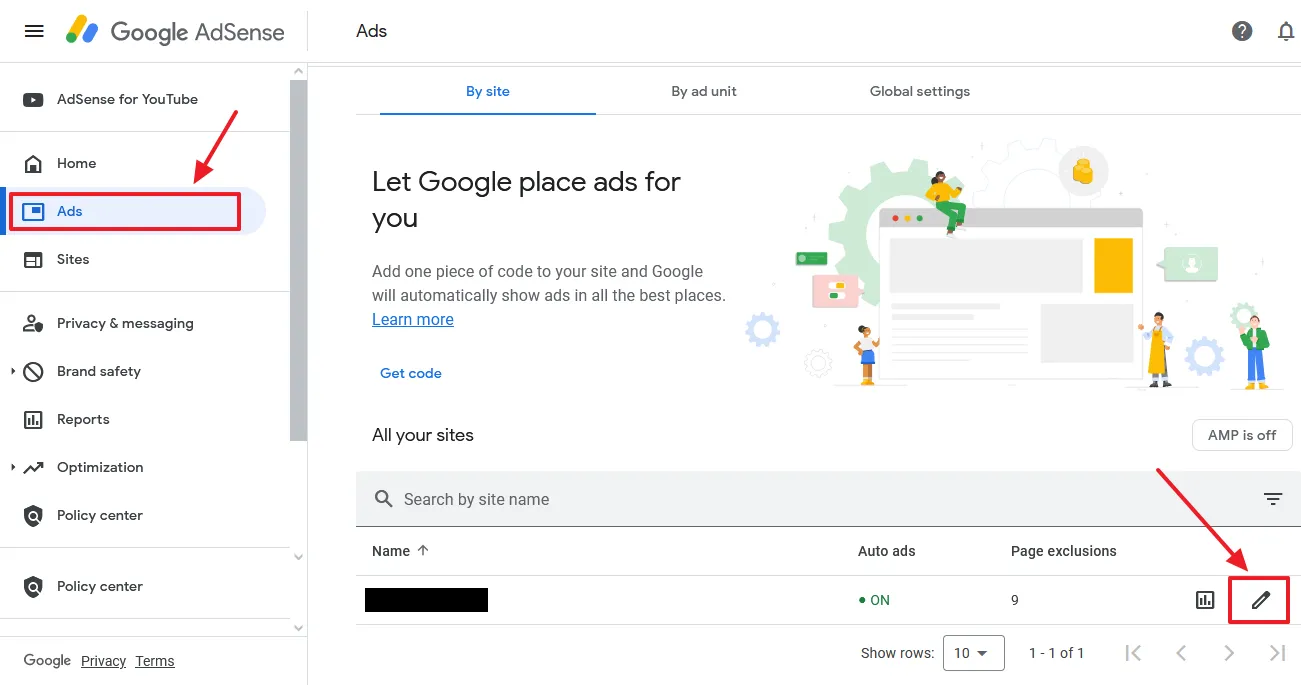
- At your right-side you can see the Ad formats under the Ad settings.
- You can see the all 5 ad formats. Select the ad formats individually that you want to enable.
- Click on the Apply to site after you’re done..
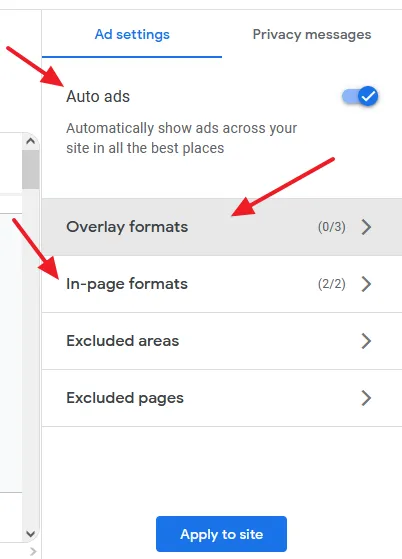
05. Use Display/Responsive Ad Format
Google AdSense offers you different type of Google Ads i.e. Responsive(Display) Ads & Fixed Ads. Display Ad units are responsive by default. There are 2 benefits of responsive ads:
- They automatically adjust their size according to the available space and type of device like computers, tablets, and smartphones. Regardless of which device users use to visit your site, Display Ad units can help you provide a great ad experience.
- Responsive Ads increase your AdSense revenue by displaying the most relevant ads, but how?
Majority visitors don’t click on the irrelevant ads. This is where the Responsive Ads give you the extra edge because when Google AdSense finds the relevant ad to your content it displays the most suitable banner provided by the advertiser. Google AdSense also recommends to use the Display/Responsive Ads.
How To Create Display Ad Units
Follow the steps to create Display Ad Units on AdSense account.
- Go to your Google AdSense account.
- Click on the Ads from sidebar.
- Click on the By ad unit tab.
- Click on the Display ads.
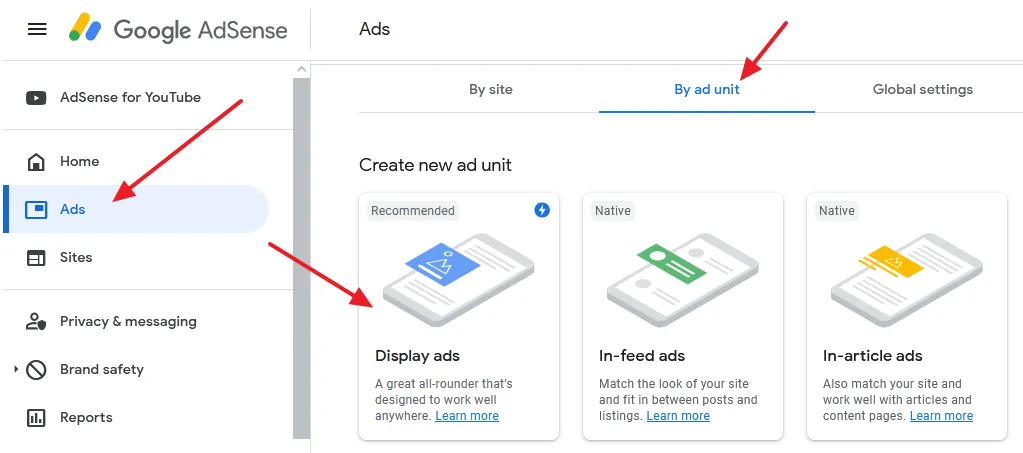
- Choose the shaped of the ad i.e. Square, Horizontal, Vertical.
- Enter a meaningful name to Ad Unit.
- Select the Ad size. There are two options (1) Responsive (2) Fixed.
- Click on the Create button.
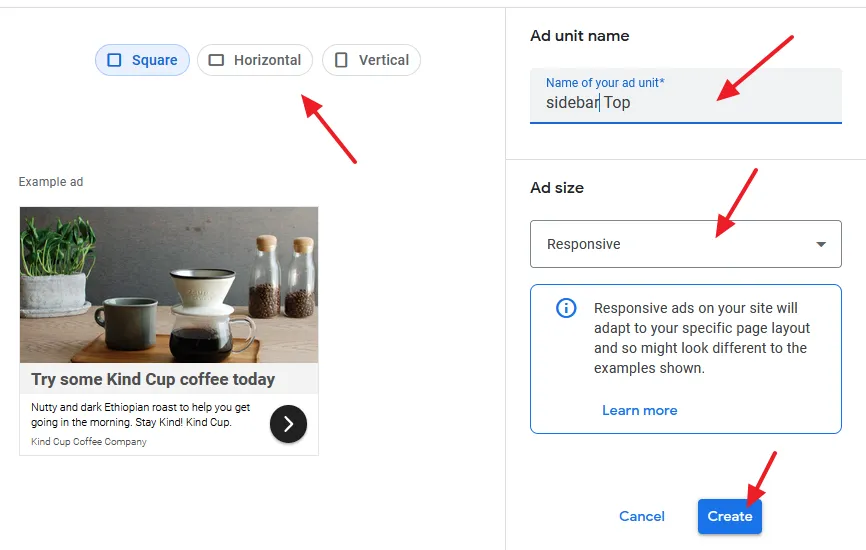
- To edit your existing ads unit scroll down to Existing ad units section.
- Click on the Edit (Pencil) icon and make the changes.

06. Test Ads On Different Slots
Google AdSense provides you the detail report about each Ad Unit like how much revenue each ad unit generates, its clicks, CPC, CTR, etc. You can also change the slots of ads as well like the ad that does not perform well might perform better on some other slot.
It is a best practice to optimize your website design for ads. The ads should be placed in a way that they should not tease the website visitors and clearly visible.
How To Check Which Ad Unit Brings How Much Revenue In AdSense
- Open your AdSense account.
- Click on the Reports.
- Click on the Ad units.
- You can check each Ad Unit’s estimated earnings on graph as well as on detail report.
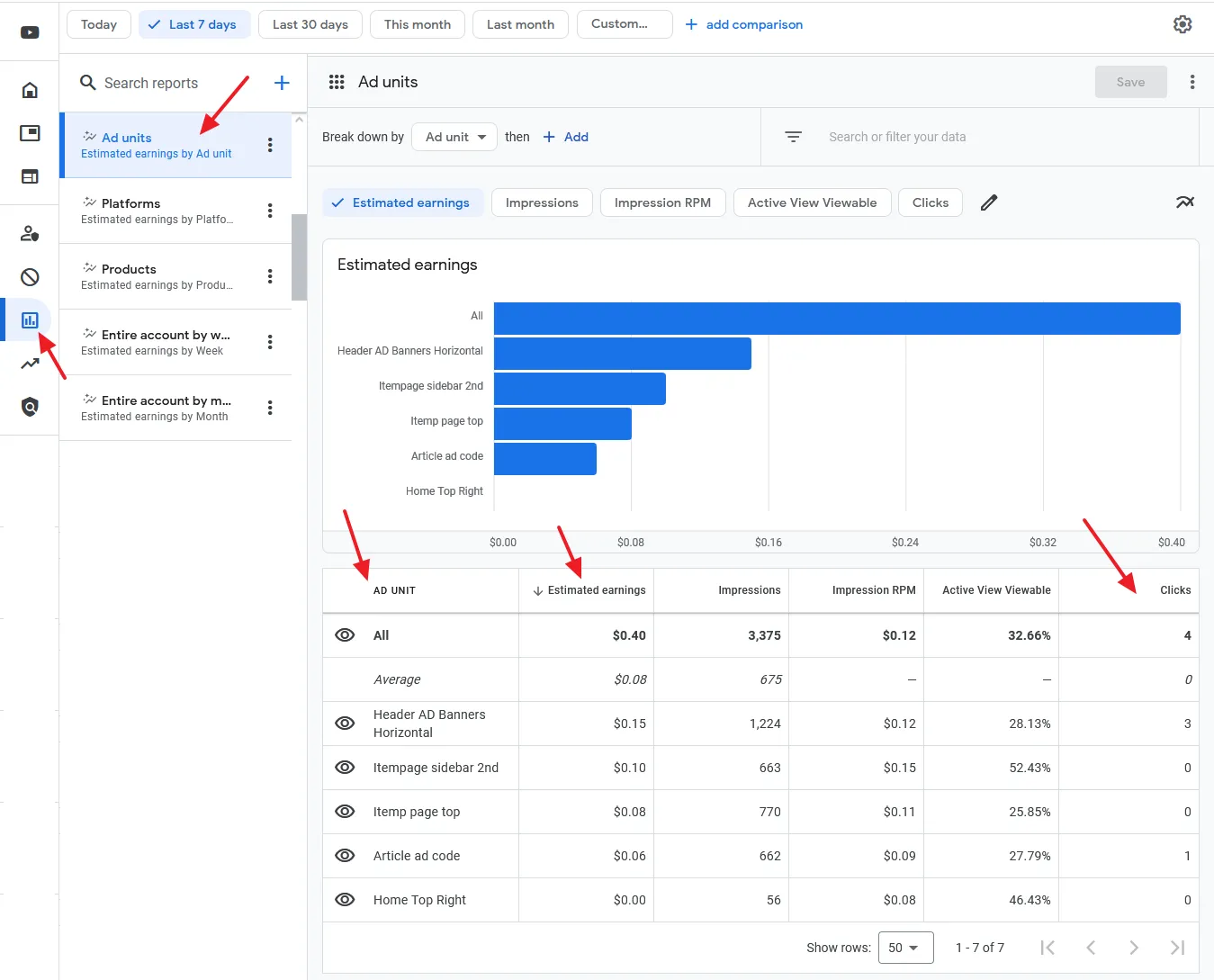
07. Target Countries With High CPC Rates
As I have mentioned earlier that every keyword has different bid rate per click and it also varies from country to country. Advertisers from countries like United States, UK, Norway, Canada, etc, offer high bid rates as compared to countries like India and Pakistan.
Google AdSense provides you detail report about Countries where you can see your estimated earnings from each country. You will see that RPM, CPC, & CTR vary from country to country.
So by analyzing this report you can target those countries more from where your ads are getting more money. This can greatly increase your Google AdSense revenue.
How To Check Countries Report On AdSense
- Open your Google AdSense account.
- Click on the Reports from the sidebar.
- Click on the Countries.
- Below are the statistics for last 7 days of a blog. You can see that how regions impact your AdSense earnings.

08. Use AdSense Ready Responsive Templates
Advance responsive AdSense Ready templates/themes also have huge impact on your AdSense revenue. Responsive templates are designed in a way that they fully support AdSense ads. Often people use templates which are not compatible with AdSense and not suitable for displaying ads, ultimately results in poor AdSense revenue.
In Responsive templates special slots are allocated for ads where they can be easily noticed without disturbing the design & content, which ultimately brings more clicks on ads. More clicks means more AdSense revenue.
On below links you can find top quality professional responsive templates:
So this post ends here with the last tip. I hope that you must have learnt lot of important things about Google AdSense and how to increase your AdSense revenue. If you like this post then don’t forget to share with other people. Share your feedback in the comments section below.
Also Read






Leave a Reply